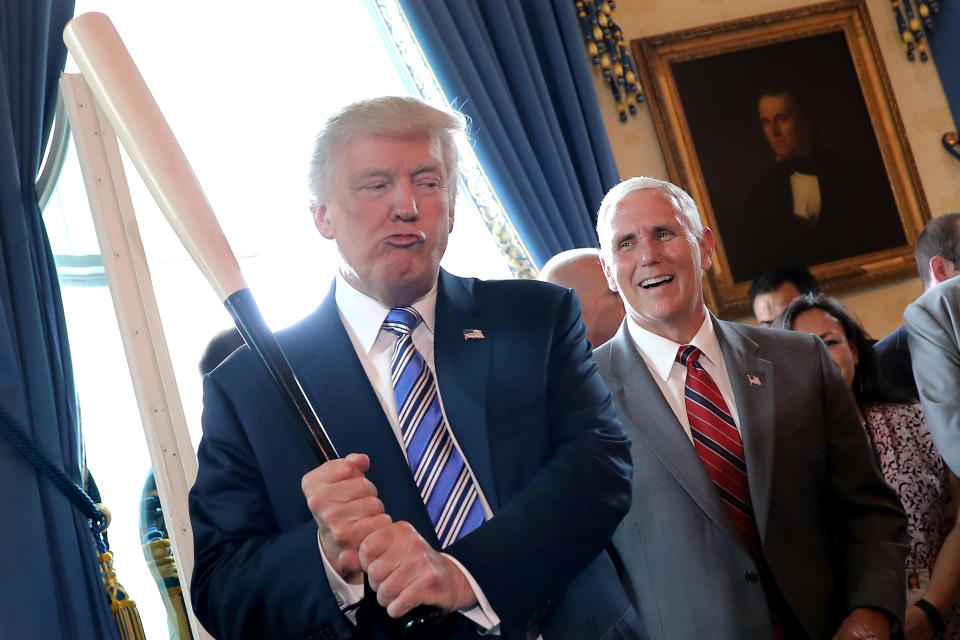Trump tariffs could make metal baseball bats more expensive
President Trump’s announcement on Thursday that he plans stiff tariffs on steel and aluminum imports sent stocks tumbling and prompted fears of a trade war. The news has also led consumers to worry about the cost impact on cars, appliances, or anything in a can, like soup or beer.
But there’s another surprise item where the tariffs would have a significant impact: baseball bats.
More than 90% of baseball bats used in the U.S. are made of aluminum. In professional baseball, players use wood bats, but in college, high school, and at the youth level, with some exceptions, metal bats (or “non-wood”) are the default.

Trump has said, for now, that the tariff will be 25% on imported steel, and 10% on imported aluminum. What he has not said, and remains unclear, is whether the tariff will be only on raw materials, or on finished goods. That will be a key distinction when it comes to bats.
The vast majority of U.S. bat makers who sell metal bats import the bats fully finished. That’s what Rawlings, Easton, and Louisville Slugger do, to name a few of the biggest. If the tariff is only on raw materials, those brands won’t be affected. Only the very small portion of American bat makers who import raw aluminum and then make their metal bats in the U.S. would see their costs rise. (They mostly get their aluminum from Canada, by the way, not China; 56% of imported aluminum to the U.S. comes from Canada, according to USGS, while only 6% comes from China.)
But if the tariff is on finished goods, metal bat makers will feel major pain; it would roil the industry. And they will have to pass that cost increase on to the consumer.
Of course, if manufacturing costs increase, “It will be a retailer’s decision as to what changes have to be made, if any, in the retail pricing,” says Larry Weindruch, spokesperson for the National Sporting Goods Association. Those retailers include wholesale chains like Dick’s Sporting Goods and Modell’s—businesses that have already been hurting badly for a few years amidst the ongoing decline of brick-and-mortar retail.
A boon for wood bat makers?
Either way, the aluminum tariff will affect the manufacturing costs of at least some metal bats. And that could be good news for wood bat makers.
“Because of the large percentage of metal bats that are foreign-made, I absolutely anticipate this being a shot in the arm, so to speak, for wood bat manufacturers,” says David Chandler, CEO of Pennsylvania-based Chandler Bats, which makes wood bats and is the favored brand of more than 50 MLB players. “It would drive home even further the value of a great wood bat product.”
And wood bats are already somewhat on the rise recently because USA Baseball issued new regulations for metal bats used at the youth level. The new rules require metal bats to be safer by somewhat sacrificing performance: youth metal bats now have to be made according to specs that diminish the speed of the ball coming off the bat. As MLB.com writes, the new rules require metal bats that “perform more like wood.” Chandler says that has already given his business a boost as parents who have a choice between metal and wood decide they’d like to try wood. (Wood bats are much cheaper, though they can break more easily.)
“We’ve already seen an immense amount of uptick in youth players, kids from 8 to 14, moving to wood bats, which makes me feel great,” he says. “Our wood is sourced here in the U.S., made here in the U.S., and sold worldwide. That goes for most of the wood bat manufacturers in the U.S.”
That’s not to say wood all bat makers should rejoice at the idea of the 10% tariff on aluminum.
A chilling effect for metal bat makers?
Chandler says he would love to make and sell metal bats, “but the extreme cost of setting up that kind of endeavor is what’s held us back. It is a major, major undertaking. The reason why there’s such a proliferation of U.S. bat manufacturers who quickly and easily jump into the metal bat market is because you can just send designs over to someone in China, you don’t even need a representative there, they send you the prototypes, you approve them, and it goes into production. There are some metal bats manufactured here, but the issue has come down to the warranty claims from U.S. manufacturers, and then you compound that with the 25% cost savings you’d get from making them somewhere else. That’s what has driven the bat industry to China.”
Trump’s tariffs would only exacerbate this issue, leading the few metal bat makers who import their aluminum and make their bats here to switch to having them made outside the U.S. to avoid the penalty.
In other words, it’s an area where Trump’s tariffs, ostensibly an attempt to boost US manufacturing, could have the opposite effect of driving US manufacturing away. (Bernard Baumohl, an economist at the Economic Outlook Group, calls the tariffs “a clear demonstration that the Trump administration does not understand trade economics” for that very reason.)
“I would expect that the small percentage of metal bat manufacturing in the U.S. might go away,” Chandler predicts. “That’s my issue to this whole approach to bolstering manufacturing in the U.S. I’m a big supporter of U.S. manufacturing; I’m a U.S. manufacturer. But to have something like that backfire and drive away business for U.S. manufacturers, we have to take a very long hard look at that approach.”
—
Daniel Roberts is the sports business writer at Yahoo Finance. Follow him on Twitter at @readDanwrite.
Read more:
MLB commissioner: ‘We are reexamining our stance on gambling’
Why the college basketball corruption probe ‘feels like a tipping point’


